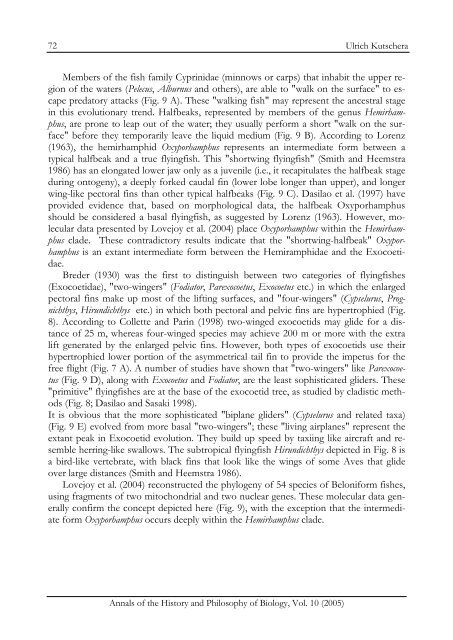Annals of the History and Philosophy of Biology
Annals of the History and Philosophy of Biology
Annals of the History and Philosophy of Biology
Create successful ePaper yourself
Turn your PDF publications into a flip-book with our unique Google optimized e-Paper software.
72<br />
<strong>Annals</strong> <strong>of</strong> <strong>the</strong> <strong>History</strong> <strong>and</strong> <strong>Philosophy</strong> <strong>of</strong> <strong>Biology</strong>, Vol. 10 (2005)<br />
Ulrich Kutschera<br />
Members <strong>of</strong> <strong>the</strong> fish family Cyprinidae (minnows or carps) that inhabit <strong>the</strong> upper region<br />
<strong>of</strong> <strong>the</strong> waters (Pelecus, Alburnus <strong>and</strong> o<strong>the</strong>rs), are able to "walk on <strong>the</strong> surface" to escape<br />
predatory attacks (Fig. 9 A). These "walking fish" may represent <strong>the</strong> ancestral stage<br />
in this evolutionary trend. Halfbeaks, represented by members <strong>of</strong> <strong>the</strong> genus Hemirhamphus,<br />
are prone to leap out <strong>of</strong> <strong>the</strong> water; <strong>the</strong>y usually perform a short "walk on <strong>the</strong> surface"<br />
before <strong>the</strong>y temporarily leave <strong>the</strong> liquid medium (Fig. 9 B). According to Lorenz<br />
(1963), <strong>the</strong> hemirhamphid Oxyporhamphus represents an intermediate form between a<br />
typical halfbeak <strong>and</strong> a true flyingfish. This "shortwing flyingfish" (Smith <strong>and</strong> Heemstra<br />
1986) has an elongated lower jaw only as a juvenile (i.e., it recapitulates <strong>the</strong> halfbeak stage<br />
during ontogeny), a deeply forked caudal fin (lower lobe longer than upper), <strong>and</strong> longer<br />
wing-like pectoral fins than o<strong>the</strong>r typical halfbeaks (Fig. 9 C). Dasilao et al. (1997) have<br />
provided evidence that, based on morphological data, <strong>the</strong> halfbeak Oxyporhamphus<br />
should be considered a basal flyingfish, as suggested by Lorenz (1963). However, molecular<br />
data presented by Lovejoy et al. (2004) place Oxyporhamphus within <strong>the</strong> Hemirhamphus<br />
clade. These contradictory results indicate that <strong>the</strong> "shortwing-halfbeak" Oxyporhamphus<br />
is an extant intermediate form between <strong>the</strong> Hemiramphidae <strong>and</strong> <strong>the</strong> Exocoetidae.<br />
Breder (1930) was <strong>the</strong> first to distinguish between two categories <strong>of</strong> flyingfishes<br />
(Exocoetidae), "two-wingers" (Fodiator, Parexocoetus, Exocoetus etc.) in which <strong>the</strong> enlarged<br />
pectoral fins make up most <strong>of</strong> <strong>the</strong> lifting surfaces, <strong>and</strong> "four-wingers" (Cypselurus, Prognichthys,<br />
Hirundichthys etc.) in which both pectoral <strong>and</strong> pelvic fins are hypertrophied (Fig.<br />
8). According to Collette <strong>and</strong> Parin (1998) two-winged exocoetids may glide for a distance<br />
<strong>of</strong> 25 m, whereas four-winged species may achieve 200 m or more with <strong>the</strong> extra<br />
lift generated by <strong>the</strong> enlarged pelvic fins. However, both types <strong>of</strong> exocoetids use <strong>the</strong>ir<br />
hypertrophied lower portion <strong>of</strong> <strong>the</strong> asymmetrical tail fin to provide <strong>the</strong> impetus for <strong>the</strong><br />
free flight (Fig. 7 A). A number <strong>of</strong> studies have shown that "two-wingers" like Parexocoetus<br />
(Fig. 9 D), along with Exocoetus <strong>and</strong> Fodiator, are <strong>the</strong> least sophisticated gliders. These<br />
"primitive" flyingfishes are at <strong>the</strong> base <strong>of</strong> <strong>the</strong> exocoetid tree, as studied by cladistic methods<br />
(Fig. 8; Dasilao <strong>and</strong> Sasaki 1998).<br />
It is obvious that <strong>the</strong> more sophisticated "biplane gliders" (Cypselurus <strong>and</strong> related taxa)<br />
(Fig. 9 E) evolved from more basal "two-wingers"; <strong>the</strong>se "living airplanes" represent <strong>the</strong><br />
extant peak in Exocoetid evolution. They build up speed by taxiing like aircraft <strong>and</strong> resemble<br />
herring-like swallows. The subtropical flyingfish Hirundichthys depicted in Fig. 8 is<br />
a bird-like vertebrate, with black fins that look like <strong>the</strong> wings <strong>of</strong> some Aves that glide<br />
over large distances (Smith <strong>and</strong> Heemstra 1986).<br />
Lovejoy et al. (2004) reconstructed <strong>the</strong> phylogeny <strong>of</strong> 54 species <strong>of</strong> Beloniform fishes,<br />
using fragments <strong>of</strong> two mitochondrial <strong>and</strong> two nuclear genes. These molecular data generally<br />
confirm <strong>the</strong> concept depicted here (Fig. 9), with <strong>the</strong> exception that <strong>the</strong> intermediate<br />
form Oxyporhamphus occurs deeply within <strong>the</strong> Hemirhamphus clade.

















